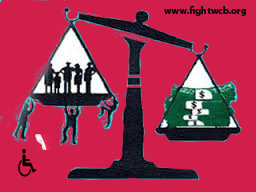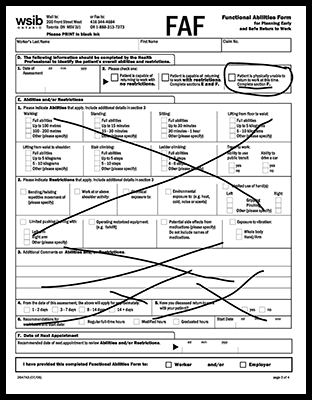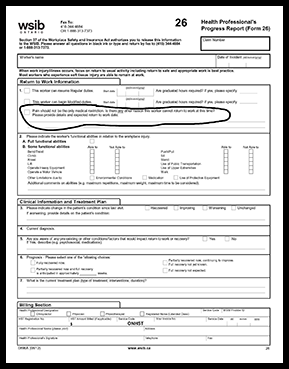WE AS INDIVIDUAL CANADIANS, HAVE A CONSTITUTIOANL RIGHT TO
TO SPEAK AND BE PART OF A GROUP!
I recently received an e-mail from a fellow injured worker. In their response, they had apologized for contacting me, and asking questions. They did this knowing I have been recently extremely busy fighting against the WCB/WCAT corruption in Canada. Regardless, one should never apologize nor be afraid to ask questions.
To this I replied. I also wanted you all to know what I had said to them...
Please never apologize for asking questions. I was raised that you learn from asking questions. I just wish I could spend all the time I would like to speak with everyone and most importantly help everyone. I do believe, in time, I might be able to do just that. I believe the best way to achieve this goal is in two simple steps. To first help myself and then secondly, to help others help themselves & help others.
First, in order to help myself, I need to ensure I am able to provide for myself and my daughter. To do this I must first win my own reconsideration appeal with Ontario’s WSIAT. Since, my first appeal to the WSIAT, in 2007, I have learned a little about the law, our rights, and most of all, the proper way in presenting an appeal to a board/tribunal/commissions, or most commonly, challenging an appeal by asking for a reconsideration of an appeal decision. A decision that was made by that board/tribunal/commission. However, to teach others, I first must be successful in my own matter. Simply put, if I can not provide for myself and my daughter than I am of no use to others!
Second,
is after helping myself I can then work on helping others. I believe this is best done by trying to encourage others to stand up and fight for themselves, or with
individuals like yourself, to have a renewed fight for themselves and others.
To most importantly understand how they can win their case. Then to teach them to fight for others and
teach others to do the same.
For example, in a very small way I was able to
encourage a few injured workers in Manitoba to come together and maybe one day
form a provincial injured worker group. I recently heard that the Canadian Injured Worker Alliance
- CIWA is working to help these individuals come together to form a
provincial group. As
I said to one of the individuals in Manitoba, I want, nor do I take
no credit for this. This is because I have no interest in taking any credit. All
I want to do is to
“piss off the WSIB & the WSIAT and all WCBs and WCATs everywhere!”
It is funny, as this exact statement was quoted by the WSIB and the WSIAT in their Case Conference Brief to the Court. You can see the WSIB/WSIAT's case conference brief by clicking here. My quote is located at paragraph 6.
Many others would be fearful of being so closely monitored by a government agency, such as Ontario’s WSIB (Ontario's workers compensation board). At times, I must admit, I do worry I maybe, one day, wrongly persecuted by Ontario’s WSIB, or another Ontario government agency. Much like, so many other individuals whose only crime was to be injured or made ill by their employer’s workplace. This fear in Ontario is genuine, as the WSIB routinely persecutes injured workers. This was proven when the Ontario Court of Appeal dismissed three cases the WSIB was trying to persecute. I had the privilege of observing from the public gallery, when the main judge uttered the words,
"Is it not enough you took their benefits away, you have to charge them as well?"
What most concerned me as an observer to these three appeals, is that in all three, not once did I ever mention the WSIB referencing medical evidence the injured workers were in fact fully recovered or much improved as the WSIB alleged. In EVERY case the WSIB used, in legal circles what is known as lay witnesses. These are witnesses who are NOT experts, but are provided expert opinions. Opinions that are NOT based on years of education, training, and professional reputation, but instead their personal opinions.
I, nor can any others, let this fear stop us from our pursuit of justice for individuals whose only crime was being hurt or made ill by their employer’s workplace.
Many may say this is a petty reason and it is morally wrong. I disagree. This is because I take no pleasure in the workers compensation boards/tribunals/commissions displeasure from me righting their moral wrongs! I also believe it is a very good motivator for me.
Let’s not forget that on many occasions Ontario's WSIB and the WSIAT have actually taken person pleasure in the harm they have caused me and my daughter!
As part of my appeal process, I am working to provide irrefutable evidence to the public. Evidence, which confirms a WSIAT tribunal panel member is heard laughing at me. This is after she had provided me with unsolicited legal advice during the hearing. Legal advice, which I, like any person in a similar position would feel compelled to follow. This is simply because she was a decision maker who was deciding the fate of my case. I like any other person would not want to upset them in anyway and would follow their instructions, or more accurately legal advice. Even if I really did not want to. Legal advice, I add, that was not only wrong but was not allowed to be provided to me by a decision maker of the tribunal. According to the tribunal's own rules of conduct for panel members and most importantly, the Rule of Law. Specifically, provide the right to all parties in a proceeding to have an impartial decision maker.
Ironically, having the behaviour of taking pleasure, laughing at another after causing them great harm, as the panel member did to me and my daughter, is something I learned in a philosophy of law class at university, is the legal definition of pure evil.
So, if the Ontario WSIB and WSIAT have acted with evil intentions towards me and my daughter I ask you, why can I not make their life just a little difficult too?
Many would say it is vengeance and thus morally wrong. However, unlike the WSIB and the WSIAT, I take no pleasure in their discomfort, I only take pleasure in knowing that someday justice will be provided to all individuals in Canada and elsewhere, including and especially those individuals whose only crime was being injured or made ill from their employer’s workplace.
I hope you and others take inspiration in my determination to fight for justice and develop a fight or renewed fight, as well as to encourage others to do the same.
I close with this thought...
Most individuals, whose only crime was being injured or made ill by their employer’s workplace, fear acts of reprisal and retaliation for simply speaking out or simply being part of or even attending an injured worker group. They should and must not. This is because as Canadians we all have Constitutionally protected Charter Rights. These rights generally sit above all laws in Canada. I say generally, as these rights can be taken away by a judge, by a Legislature, or by Parliament. This is referenced within sections 1 and 33 of the Charter.
One
of these specific rights individuals are guaranteed is the right to Freedom of Expression.
This includes the right to freedom of speech, which is stated within section 2(b)of the Charter.
I caution that one has the right to free speech, so long as the speech
they utter is not making a false statement and/or the speech does
not involve hate speech.
Another
one of these specific rights is the right to Freedom of Association. This
includes the forming of and being a member of a group. Most importantly not to be punished in any
way, as a result of forming and being part of that group. This is stated within
section 2(c) of the Charter.
I
caution that one has the right to freedom of association, so long as the group
or association to the group does not promote, or cause to occur hatred,
violence, or harm of others.
Even saying that one has rights, which are guaranteed above all other laws, countless individuals still fear acts of reprisal and retaliation from workers compensation boards, tribunals/commissions. Moreover, they also fear acts of reprisal and retaliation from their employers.
Countless individuals still fear acts of reprisal and retaliation from workers compensation boards, tribunals/commissions. Moreover, they also fear acts of reprisal and retaliation from their employers!
Sadly, there is no Constitutional protection from employers/business
for violating our Charter Rights.
A clear intentional flaw within our Constitution!
In the cases where individuals who have genuine fear from acts of reprisal and retaliation, I suggest they can do like Canada’s workers compensation boards/tribunals/commissions do, that is act in the shadows.
Some examples are:
· When attending in-person meetings, seminars, and events, such as injured worker protest rallies and marches, these individuals can wear face masks and sunglasses to protect their right to their privacy by preventing being wrongly persecuted.
· When doing things online, like posting online comments, such as the harsh and inhumane treatment by their employers, the workers compensation boards/tribunals/commissions regarding their forced return to work programs, they can,
o Consider setting up and using a different online account;
o Consider setting up and using a separate e-mail account;
o Consider using strong anti-virus, firewall and most importantly VPN (Virtual private network) software to fully protect your privacy while you are online;
o When attending ZOOM meetings change your name to an alias; never provide personal details when attending an online meeting like ZOOM, and
o There are also many other ways as well you can find out by searching on the internet.
· Most importantly NEVER invoke harm or violence
of any kind to ANYONE! This will guarantee, get the attention of law enforcement
and cause serious harm to the overall movement.
Even though, the workers compensation
boards/tribunals/commissions intentionally harmed us, let’s show them we are
better than them and wish them no harm!
Let’s never forget that we are not just injured workers or individuals, but we are Canadians and as such we have rights! That our rights are only ever protected so long as we fight within the system to protect them, ourselves!
I hope you and others are inspired to join or rejoin
the fight for justice for injured workers!


